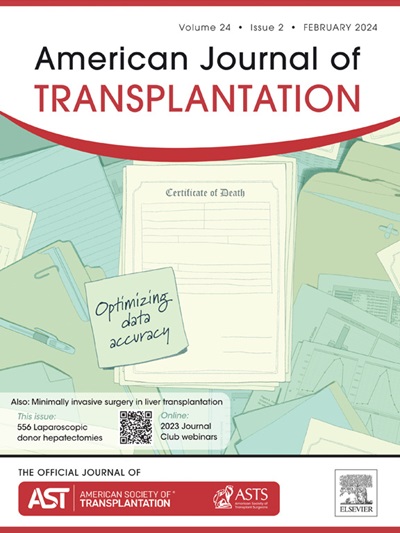Underrecognition of deceased-donor kidney out-of-sequence allocation due to increasing use of free text coding.
IF 8.9
2区 医学
Q1 SURGERY
引用次数: 0
Abstract
Out-of-sequence (OOS) allocation, the process by which organ procurement organizations (OPOs) can deviate from standard rank lists of potential recipients to expeditiously allocate deceased-donor kidneys, is rising in the U.S. We aimed to determine whether current OPO reporting practices obscure the extent of OOS allocation. Using match-run data for all U.S. deceased-donor kidney transplants from 2021-2023, we defined "miscoded" OOS (mOOS) allocation transplants as those with use of the 799 or 898 OPO-initiated refusal codes ("other, specify") with free text responses clearly indicating OOS allocation, and compared these to "explicit" OOS (eOOS) allocation, wherein OOS transplants are appropriately coded using refusal codes 861-863. We found that the prevalence of mOOS allocation increased from 2021 (122 transplants) to 2023 (430 transplants) and accounted for 12% of all OOS transplants by 2023. Organs allocated via mOOS had a lower median KDPI than those allocated via eOOS (51% vs 55%, p <0.01). While an increasing number of OPOs used mOOS throughout the study period, the practice remained concentrated overall, with 5 "high-frequency" OPOs performing 66% of mOOS allocations in 2023. These findings highlight the need for stricter oversight of organ allocation and underscore the responsibility of the OPTN to ensure proper data reporting.由于越来越多地使用自由文本编码,对已故供体肾脏乱序分配的识别不足。
在美国,器官采购组织(OPO)偏离潜在受者的标准排名名单,以迅速分配已故供者肾脏的失序分配(OOS)现象正在增加。我们旨在确定目前的OPO报告实践是否掩盖了OOS分配的程度。使用2021-2023年美国所有已故供体肾脏移植的匹配运行数据,我们将“错误编码”OOS (mOOS)分配移植定义为使用opo发起的799或898拒绝代码(“其他,指定”)的移植,并将其与“明确”OOS (eOOS)分配进行比较,其中OOS移植使用拒绝代码861-863进行适当编码。我们发现mOOS分配的流行率从2021年(122例移植)增加到2023年(430例移植),到2023年占所有OOS移植的12%。mOOS分配器官的KDPI中位数低于eOOS分配器官(51% vs 55%, p <0.01)。尽管在整个研究期间,越来越多的opo使用mOOS,但总体而言,实践仍然集中,5个“高频”opo在2023年占mOOS分配的66%。这些调查结果强调需要对器官分配进行更严格的监督,并强调OPTN有责任确保适当的数据报告。
本文章由计算机程序翻译,如有差异,请以英文原文为准。
求助全文
约1分钟内获得全文
求助全文
来源期刊
CiteScore
18.70
自引率
4.50%
发文量
346
审稿时长
26 days
期刊介绍:
The American Journal of Transplantation is a leading journal in the field of transplantation. It serves as a forum for debate and reassessment, an agent of change, and a major platform for promoting understanding, improving results, and advancing science. Published monthly, it provides an essential resource for researchers and clinicians worldwide.
The journal publishes original articles, case reports, invited reviews, letters to the editor, critical reviews, news features, consensus documents, and guidelines over 12 issues a year. It covers all major subject areas in transplantation, including thoracic (heart, lung), abdominal (kidney, liver, pancreas, islets), tissue and stem cell transplantation, organ and tissue donation and preservation, tissue injury, repair, inflammation, and aging, histocompatibility, drugs and pharmacology, graft survival, and prevention of graft dysfunction and failure. It also explores ethical and social issues in the field.

 求助内容:
求助内容: 应助结果提醒方式:
应助结果提醒方式:


